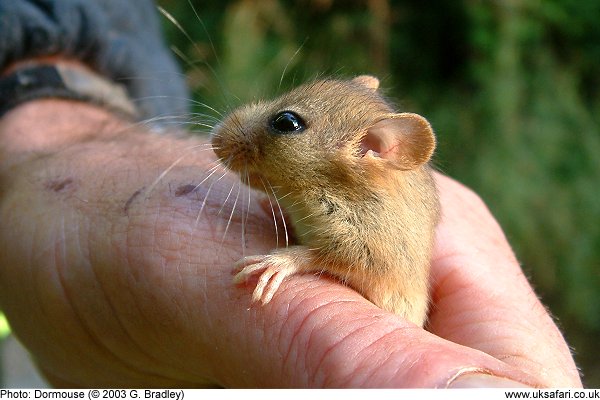 Dormice
DormiceIdentify It > Mammals Section > Dormice >

Scientific name: Muscardinus avellanarius
Size: Approximately 70mm long, and the thick furry tail is about the same length as the body. During the summer, adults weigh between 17 and 20 grams, but before hibernation in autumn they almost double their weight
Distribution: In England Dormice are mainly found in the south, from Cornwall to Kent, and northwards to Herefordshire and Northamptonshire. They can be found throughout most of Wales, but not in Scotland
Months seen: Dormice are active at night between April and October. In autumn, after the first frosts, they go into hibernation until spring
Life Span: Up to five years (longer than other small rodents)
Habitat: Dormice live in broad-leaved deciduous woodland and in thick hedgerows. Dormice need a habitat containing a variety of trees and shrubs to ensure a continuous supply of food. Hazel, honeysuckle, bramble and oak provide most of their food.
Food: Nuts, fruit, flowers, pollen and insects
Special features: Dormice can be easily distinguished from other mice by their hairy tail. The fur is an orange-brown colour, and they have long whiskers.
One of the favourite foods of the dormouse is hazelnuts, which they eat while they're still green and on the tree. If you find a hazelnut shell with a perfectly round, smooth edged hole in the side, it's quite likely that you're in Dormouse territory.
Dormice usually have one, or sometimes two litters a year. There can be three or four young which are normally born in early summer. Those born in late summer rarely survive, as they don't have sufficient time to build up enough fat reserves for the winter hibernation.
An old English name for the dormouse is 'sleeper', in fact the word 'dormouse' literally means sleeping mouse. The hibernation nest of the dormouse is built on the ground or very low down amongst vegetation. It's tennis ball sized, and usually made from dry grass, leaves and the bark of honeysuckle. The dormouse crawls inside and curls up into a tight ball to sleep.
During hibernation Dormice allow their body temperature to drop to that of their surroundings. Their heart and breathing rate can be reduced by 90% or more. If the air temperature drops below zero they "switch on" just enough body systems to keep their blood from freezing.
Note: Dormice are a protected species and you need a licence to handle them.
 Related Pages
Related Pages

 Popular Pages
Popular PagesAmphibians, Bats, Badgers, Beetles, Birds, Birds of Prey, Bumble Bees, Butterflies, Caterpillars, Climate Change, Deadly Spiders, False Widow Spiders, Frogs, Garden Spiders, Glow-Worms, Hedgehogs, House Spiders, Owls, Spiders, Toads, What's Out Now?
Copyright © 2024 G. Bradley UK Safari. All rights reserved | About Us | Links | Advertise | Contributors